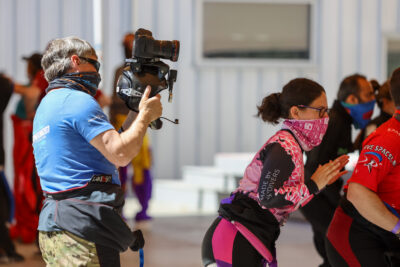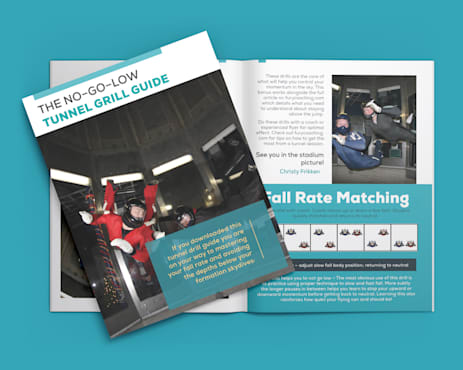Laser Sharp Focus for Distractable Skydivers
Monday, August 30, 2021

So many shiny things! I am grateful my competition is only 35 seconds to keep my attention span. But there are still many ways to be distracted while you are jumping!
Task Relevant vs. Task Irrelevant
If you have goals while you are skydiving, you want to stay focused on the most critical tasks. But your brain is scanning the environment looking to pull your attention towards other stuff. In jumping, some of this stuff is relevant to your safety and needs immediate attention. Some of it will have a direct impact on your ability to perform. Much of it has no bearing on how your jump will turn out. The trick is to learn the difference.
Stuff that Matters
A task-relevant cue needs attention. Any safety-related issue is immediately relevant. Obstacles or situations that impeded your ability to do the job you want are relevant too. Examples of task-relevant issues before a jump are gear problems, airplane banking, or video issues. During a jump, task-relevant stuff might include the build, the next point, or team levels.
Any safety-related issue is immediately relevant.
Gear changes
When I have new gear, I feel every little difference! Just knowing you have a new piece of equipment draws your attention and can creep up at any time during a skydive.
This one isn’t always bad. A gear change deserves a little extra attention for safety’s sake. Consider jumping or flying with the gear before you get deep into a training day. Hop n’ Pops are great for this! Low passes give you time to adjust to any differences and learn about your new stuff.
Unusual stuff/safety
Unusual circumstances are another type of distraction that can help keep you safe. If you see something weird and out of place, your brain may flag it as a problem. That flash in the in freefall could be a bird, but it might be another jumper. A group of new jumpers organizing a raft dive right behind your team could be a severe hazard. Taking some time to figure out the plan is worth the mental time.
If something doesn’t seem right, it is worth being “distracted” enough to investigate further.
Irrelevant distractions
If you make a list, you will be surprised at how most activity doesn’t directly influence your jump.
You could have an incredible jump even if:
- The call was pushed back
- There was an argument in the plane
- It was raining
- You forgot your gloves
- Your hair tie broke
- Your boss texted you for a TPS report
- You circled at altitude for 30 minutes
- The coach yelled at you on the last jump
- Someone ate your granola bar
These piled-on challenges might not make it easy, but you could make it a great skydive. Those things have no significant direct effect on your performance. You could still win with all of that going on!

Other jumpers
Other people are a common source of distraction. Jumpers on the dropzone and plane naturally draw our attention. The distraction might be a friend we want to talk to or a noisy group driving you crazy. It boils down to the same energy drain and can keep you from focusing on the task at hand.
Recognizing the distraction is most of the battle when it comes to other people. A quick and dirty tip is to wear earplugs on the plane – let those jumpers chat all they want!
Performance Anxiety
If you care about your performance, you may feel enough anxiety to become a distraction on its own. Getting jitters is ok! Feeling nervous before a big jump is just how your body gets ready to perform. Plus, that excitement is part of the fun.
You can cope with this by reinterpreting your feelings as excitement as opposed to fear. Learn to trust your training and yourself!
Physical state
Are you tired, hungry, thirsty, sick, or hungover? That is sapping some of your mental focus for sure. Please do your best to keep yourself in good physical shape, so your mind can spend all of its power focusing on performing and safety.
If your state is too bad, seriously consider calling it a day. Lack of focus leads to errors, which in this sport can result in accidents. If it is only a moderate issue, develop your mental toughness to work through less than perfect days.
Work/Real Life
It is hard not to think about to-do lists, relationship stress, and work while sitting quietly on a plane for 20 minutes. These issues are often pressing and can draw your attention to them.
First, permit yourself to jump. If you are at the DZ, you should allow yourself to embrace it to return to real life, relaxed and ready.
Second, if your work or life is urgent, you can decide to take breaks from your training or jumping in the day to allow yourself to dive in. For example, decide you will check your email after the big way debriefs but not beforehand. Knowing you have set aside time to deal with mundania, you can embrace what is happening at the moment.
A part of the skydive
I have gotten so focused on an exit before that I have forgotten the rest of the jump completely. It is easy to overthink one bit of a skydive in exclusion of everything else. Overthinking about one part can create tunnel vision. By intently looking at the tree in the landing area, you can lose track of other traffic and threats.
The best solution here is an adequate prep plan that ensures good coverage of your whole jump. If you stick to your plan, you will know you have prepped everything evenly.
Going Further – make a log
If you want a laser-sharp focus for training, you can start improving by making a distraction log. You can add it to your logbook or your training notes; jot down any distractions that pulled your attention away on a typical jumping day. Do this for a handful of jumps so you can find any patterns.
Recognize
Soon you might find a pattern or category of distraction that unfocuses you. Scan through your distraction log and come up with a few types of distractions you would like to fix and list them out.
Examples:
Someone talking too much on the plane
A stairstep diamond exit
Work thoughts
When you create a list, you may start noticing these as they happen. That is great! The first step is to recognize when it is happening to redirect your brain back to your new plan.
Regroup
When you start to think about a distraction and notice it, you’ll need to stop yourself. It can help to give yourself a regrouping phrase to get you back on track. If your distraction occurs in freefall, keep the regrouping cue to a short one or two-word jolt like “Later” or “Be Here.”
| Distraction | Regroup phrase |
| Someone talking too much on the plane | This doesn’t have anything to do with my jump |
| A stairstep diamond exit | I have visualized and practiced this exit correctly; it will be good enough |
| Work thoughts | I can’t fix anything right now; I deserve the chance to focus on my jump. |
Refocus
Finally, you have noticed a distraction; you have regrouped. Next, think about what you would help your skydive. Again, if you are in freefall keep it short.
| Distraction | Regroup phrase | Refocus |
| Someone talking too much on the plane | This doesn’t have anything to do with my jump | Back to visualizing |
| A stairstep diamond exit | I have visualized and practiced this exit correctly; it will be good enough | Focus on the rest of the jump too
|
| Work thoughts | I can’t fix anything right now; I deserve the chance to focus on my jump. | Next Point |
Putting it all together, recognize when you are being distracted, take a second to regroup, then refocus on the task at hand. Keep the log going to see your improvements or add new types of distractions as they pop up.




